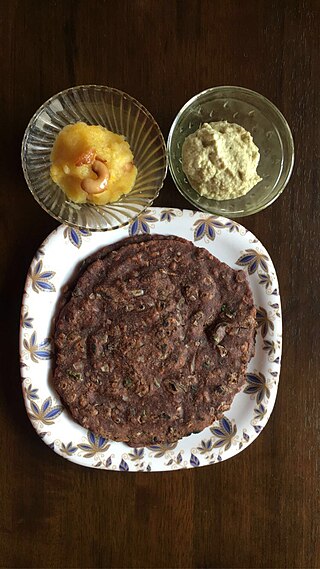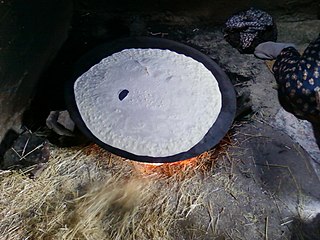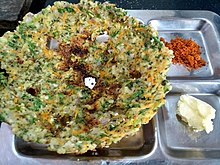
Chapati, also known as roti, rooti, rotee, rotli, rotta, safati, shabaati, phulka, chapo, sada roti, poli, and roshi, is an unleavened flatbread originating from the Indian subcontinent and is a staple in India, Nepal, Bangladesh, Pakistan, Kyrgyzstan, Sri Lanka, the Arabian Peninsula, East Africa, and the Caribbean. Chapatis are made of whole-wheat flour known as atta, mixed into dough with water, oil (optional), and salt (optional) in a mixing utensil called a parat, and are cooked on a tava.

Roti is a round flatbread originating from the Indian subcontinent. It is commonly consumed in many South Asian, Southeast Asian, Caribbean, and Southeast African countries.

Pakistani cuisine can be characterized as a blend of regional cooking styles and flavours from across South, Central and Western Asia. Pakistani cuisine is influenced by Persian, Indian, and Arab cuisine. The cuisine of Pakistan also maintains certain Mughal influences within its recipes and cooking techniques. Pakistan's ethnic and cultural diversity, diverse climates, geographical environments, and availability of different produce lead to diverse regional cuisines.

Bhakri is a round flatbread often eaten in the cuisines of the states of Gujarat, Maharashtra, Rajasthan, and Karnataka in India. The bhakri prepared using jowar or bajra is coarser than a regular wheat chapati. Bhakri can be either soft or hard in texture, unlike khakhra in respect to hardness.

Rajasthani cuisine is the cuisine of the Rajasthan state in North West India. It was influenced by various factors like the warlike lifestyles of its inhabitants, the availability of ingredients in an arid region and by Hindu temple traditions of sampradayas like Pushtimarg and Ramanandi. Food that could last for several days and could be eaten without heating was preferred.

A flatbread is bread made usually with flour; water, milk, yogurt, or other liquid; and salt, and then thoroughly rolled into flattened dough. Many flatbreads are unleavened, although some are leavened, such as pita bread.

Puran poli is an Indian sweet flatbread that is popular in South India and the state of Maharashtra. It is also known as Puran puri, Holige, Obbattu, Bobbattlu, Poley, Bakshamulu, and Boli.
Maharashtrian or Marathicuisine is the cuisine of the Marathi people from the Indian state of Maharashtra. It has distinctive attributes, while sharing much with other Indian cuisines. Traditionally, Maharashtrians have considered their food to be more austere than others.

Indian breads are a wide variety of flatbreads and crêpes which are an integral part of Indian cuisine. Their variation reflects the diversity of Indian culture and food habits.

Jhunka or Zunka is a gram flour porridge or a gram flour curry, similar to polenta. It is a traditional Indian dish prepared in Maharashtra, North Karnataka, and Goa. It is also known by the name of pithla or pithle. When served with bhakri, the dish is referred to as jhunka bhakar or pithla bhakri. Pithle is also known as chun in the Vidarbha region of Maharashtra.

Thalipeeth is a savoury multi-grain flatbread popular in Western India, particularly in the state of Maharashtra. The flour for thalipeeth, called bhajanee, is prepared from roasted grains, legumes and spices. The ingredients include grains such as rice, wheat, bajra, and jowar; legumes such as chana, and urad; and spices, most commonly coriander and cumin seeds. When preparing the dough, other ingredients such as onion, fresh coriander, other vegetables and spices are added. Thalipeeth is usually served with butter, ghee, or yogurt. The dish is popular in Maharashtra and north Karnataka, and it is also made with regional variations in Goa.

Ragi rotti is a breakfast food of the state of Karnataka, India. It is most popular in the rural areas of southern Karnataka. It is made of ragi flour. Ragi-Rotti means ragi-pancake in the native language, Kannada. It is prepared in the same way as akki rotti. The ragi flour is mixed with salt and water and kneaded well to come up with a soft dough. While making the dough, sliced onions and carrots, chopped coriander and cumin seeds can also be added for taste. Oil is spread over a griddle (tava) and a small amount of the dough is neatly spread over it to resemble a thin pancake (rotti). A small amount of oil is spread over it and the rotti is cooked on the hot griddle till it turns crisp. Ragi rotti is served hot and is eaten along with chutney.

Baigan bharta, also spelled bainganbharta or baigan chokha is an Indian dish prepared by mashing or mincing grilled eggplant (baigan) with tomato, onion, herbs and spices, with variations being common from chef to chef. Traditionally, cooking the eggplants over charcoals, inside of a tandoor, barbecue grill or oven, or even directly applying flame to the outside of the fruit infuses the dish with a smoky flavour; the blackened skin is then easily peeled and the eggplant may be further prepared.

Dhebra is an Indian bread from the Gujarati cuisine made of pearl millet flour. When flavoured with fenugreek leaves, it's called methi dhebra. It is a cuisine cousin of the flatbread called Thepla.

Malaysian Indian cuisine, or the cooking of the ethnic Indian communities in Malaysia, consists of adaptations of authentic dishes from India, as well as original creations inspired by the diverse food culture of Malaysia. Because the vast majority of Malaysia's Indian community are of South Indian descent, and are mostly ethnic Tamils who are descendants of immigrants from a historical region which consists of the modern Indian state of Tamil Nadu and Sri Lanka's Northern Province, much of Malaysian Indian cuisine is predominantly South Indian inspired in character and taste. A typical Malaysian Indian dish is likely to be redolent with curry leaves, whole and powdered spice, and contains fresh coconut in various forms. Ghee is still widely used for cooking, although vegetable oils and refined palm oils are now commonplace in home kitchens. Before a meal it is customary to wash hands as cutlery is often not used while eating, with the exception of a serving spoon for each respective dish.

Roti canai, or roti prata, also known as roti chanai and roti cane, is an Indian flatbread dish found in several countries in Southeast Asia, especially Brunei, Indonesia, Malaysia, Singapore, and Thailand. It is usually served with dal or other types of curry but can also be cooked in a range of sweet or savoury variations made with different ingredients, such as meat, eggs, or cheese.

Paratha is a flatbread native to the Indian subcontinent, with earliest reference mentioned in early medieval Sanskrit, India; prevalent throughout the modern-day nations of India, Pakistan, Nepal, Bangladesh, Maldives, Afghanistan, Myanmar, Malaysia, Singapore, Thailand, Mauritius, Fiji, Guyana, Suriname, and Trinidad and Tobago where wheat is the traditional staple. It is one of the most popular flatbreads in the Indian subcontinent and the Middle East. Paratha is an amalgamation of the words parat and atta, which literally means layers of cooked dough. Alternative spellings and names include parantha, parauntha, prontha, parontay, paronthi (Punjabi), porota, paratha, palata, porotha, forota, farata, prata, paratha, buss-up shut, oil roti and roti canai in Malaysia and Indonesia.

Saj bread or tava bread is unleavened flatbread in Middle Eastern and South Asian cuisines baked on a metal griddle, called saj in Arabic and tava in the Indian subcontinent.

Arab Indonesian cuisine is characterized by the mixture of Middle Eastern cuisine with local Indonesian-style. Arab Indonesians brought their legacy of Arab cuisine—originally from Hadhramaut, Hejaz, Sudan and Egypt—and modified some of the dishes with the addition of Indonesian ingredients. The Arabs arrived in the Nusantara archipelago to trade and spread Islam. In Java, since the 18th century AD, most of Arab traders settled on the north coast and diffuse with indigenous, thus affecting the local cuisine culture, especially in the use of goat and mutton meat as well as ghee in cooking.


















